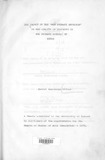| dc.description.abstract | The study looks into the problem of quality in teaching in the light of a pupil-centred lesson as opposed to a teacher-dominated lesson. It recognises the fact that quality in teaching has no universally accepted definition nor are many educators agreed on what constitutes it. It traces how the problem of quality in teaching in the schools of Kenya has been a standing problem since the introduction of Western education; a problem about which much has been said, but little done to tackle it.
This was largely bedause of the colonial policy towards education for Africans, which laid heavy stress to the provision of education for •adaptation'. The adaptation policy restricted the expansion of African literary education and hence focusing African demands to the provision of more literary education and generally paying less attention to the problem of quality in teaching. Some Christian missionaries, however, made attempts to improve the quality of primary education, through the expansion of teacher education but largely failed because
of little or half-hearted support given by the government.
^ The end of the second World War sparked a general expansion in education particularly the growth of primary education whose corollary was expansion in primary teacher education. Generally expansion in primary education outpaced the production of a sufficient number of teachers and this led to the employment of a high preportion of untrained teachers and poorly qualified teachers. These two factors made it difficult to upgrade the quality of teaching through the education of teachers.
Education commissiors set up to study the education system either in Kenya or in East Africa after the war particularly in the fifties,expressed general dissatisfaction about the quality of teaching in the primary schools arising from untrained teachers and a large proportion of poorly qualified teachers most of whom used traditional methods of teaching.
They stressed the need for introducing activity methods of teaching. At the same time general
concern was mounting in the country about poor examination performance of the African and Asian pupils on the English paper. It was felt that the subject was generally poorly taught. This led to the introduction of the English Medium in 1957 beginning with the Asian primary schools and extending lit later to the African primary schools in 1961. The programme later known as the 'New Primary Approach' was pegged to the teaching of English from standard one of the primary schools, though its architects saw it as a general 'revolution' in the quality of teaching in the schools of Kenya. A lot of efforts were made to make teachers conceive it as a general revolution in the teaching methods of the primary school based on a pupil-centred approach, and as having introduced progressive education into the Kenya education system. Much was said about the programme having introduced a practical approach to teaching, particularly before its expansion was curtailed in 1967, but many of the impressions were based on the teaching of English as an index of improving the quality of teaching.
An examination of the teachers' and pupils' class activities does not seem to support the 'frantic' generalizations and impressions made about the achievements of the Nev; Primary Approach in upgrading the quality of teaching. Teaching in most of the primary schools remains strongly teacher-dominated for those teachers who attended the programme and for those who did not attend it. Though the effects of the programme are to a lesser degree manifested in the lessons of teachers who were introduced to the programme through in-service courses. Primary teachers, primary college students and
I
tutors, generally attribute the failure of tie 'New Primary Approach' to have a strong influence on the quality of teaching, to the poor methods through which it was introduced, lack of proper teaching facilities and the Certificate of Primary Education examination factor in the primary schools.
In the study, other factors affecting the quality of teaching; the teachers'academic and professional level, teaching in lower or upper classes of the primary school, teachers'sex
differences, age, teaching experience and whether or not the teacher observed was preparing for an external examination and the pre-service education of primary teachers are examined. It is revealed that teaching in the Lower or in the Upper classes of the primary school has a very powerful effect on the quality of teaching. There is a strong reflection of pupil-centred education in the lower classes declining sharply in the upper classes particularly in class seven of the primary school. This pointed to the Certificate of Primary Educ tion examination as being a very ‘critical’ constraint to the quality of teaching. Of the other factors examined PI teachers and women teachers tend to be a positive element in the quality of teaching »while preparing for the external examinations tends to prohibit teachers' approach to activity methods of teaching.
The conclusion stresses the need of emphasising activity methods of teaching in Kenya’s education system because they are in line with its educational aims. It recommends the reorganization of activity methods in the pre-service and in-service teachers* courses to make the methods more
meaningful; an examination of the place of the Certificate of Primary Education in relation to teaching in the primary schools; increase in the proportion of the highly qualified teachers and women teachers; improvement in the supply of teaching material and a critical examination of the pre-service teachers* courses as means of improving the quality of teaching in the primary schools.
I | |

